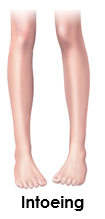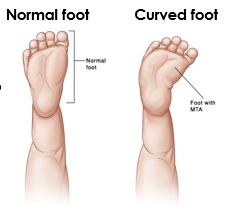Intoeing and Outtoeing
What is Intoeing and Outtoeing?
Intoeing and Outtoeing:
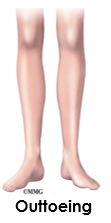
Both conditions:
- May run in the family (genetic).
- May be caused by the baby’s position in the uterus.
- Are common in young children.
- Rarely need treatment since most children outgrow it.
- Will not affect your child’s ability to walk, run or play.
Sometimes severe intoeing can cause a young child to trip and fall. Falling often comes with learning to walk, so may not be caused by intoeing. If your child has intoeing or outtoeing and severe pain, swelling or a limp, they should be seen by an orthopedic provider.
What causes them?
Intoeing
There are three reasons a child may have intoeing. They can occur on their own or with other bone and muscle problems so cannot be prevented. There may be a family history.
Curved Foot, called Metatarsus Adductus (MTA). This is the most common cause of intoeing in infants. Most infants are born with this condition.
There are two types of MTA: flexible and stiff.
- Flexible MTA. This is common. It will often improve or go away on its own during the first 4 to 6 months of life. Flexible metatarsus adductus has no impact on a child’s function. Sometimes casting can be used to help the foot grow straight.
- Stiff MTA. If the foot is stiff, the healthcare provider may recommend casts. The casts stretch the foot so it can grow straight. The cast is changed as the child’s foot changes.
- If casting is done, special shoes may be needed to help maintain the corrected MTA.
- Surgery for metatarsus adductus is rare.
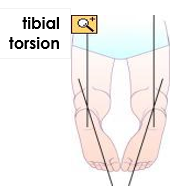
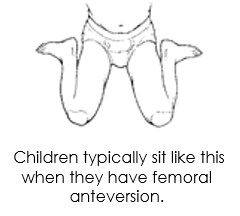
More about twisted shin and twisted thigh bone
These almost always correct by age 10. Studies have found that special braces, shoes, and exercises do not help. Children who do not grow out of these conditions are not at a bigger risk to develop pain or bone problems. If the problem does not get better on its own, surgery is the only treatment. It should only be done if there is severe deformity or if walking is hard. It also is best to wait until after age 10 for surgery.
Outtoeing
Most often, outtoeing occurs during the first year of life while your child is learning to walk. Like intoeing, it is often caused by an outward twist of the thigh or shin bone. It will almost resolve on its own as the child grows. Treatment is normally not needed.




